OK, so here we are, living in a slightly damp country where we can really only grow oats and low protein wheats (for the most part). Makes fantastic pastry, but bread... Well, out bread flour is usually augmented with Canadian or some European wheats to boost the protein levels (or additives & enzymes then beaten to hell and back by the Chorleywood process). Even then, it's not quite the same as US/Canadian flours and my attempts at a higher hydration (and others) have met with results resembling ciabatta or basically a pile of glue.
However... I was given a copy of "Tartine" for my birthday a few weeks ago, so I thought I'd give it another go...
The summary - using my usual organic Shipton Mill 12% protein flour (their No. 4) as well as their organic wholemeal basically worked, although the results were somewhat challenging.
This is what I ended up with:
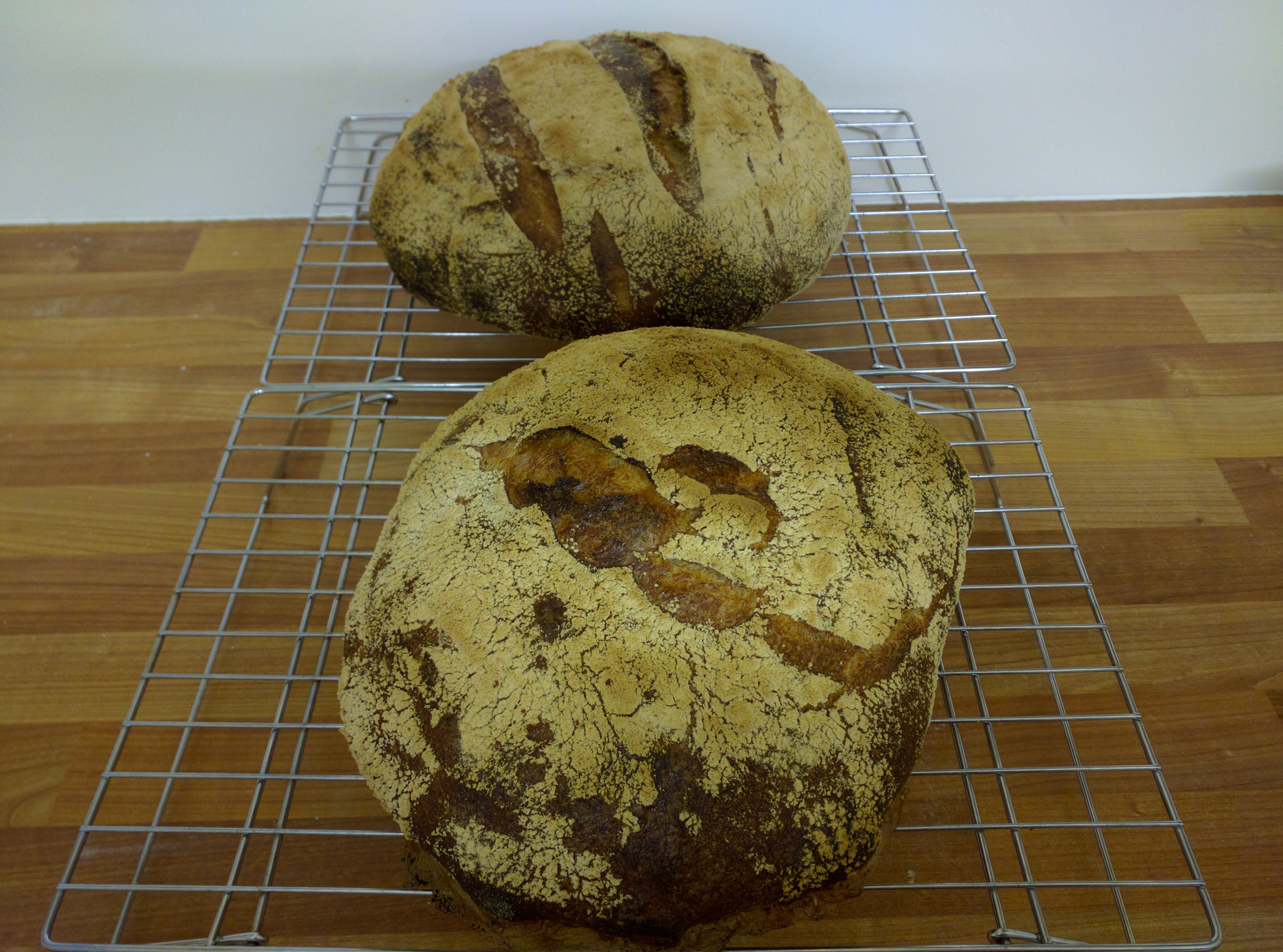
Not my best - far from it... Anyway, you ought to be able to right-click on the image to get the full-size...
And this was inside one of them: (I only waited half an hour as it was getting late)
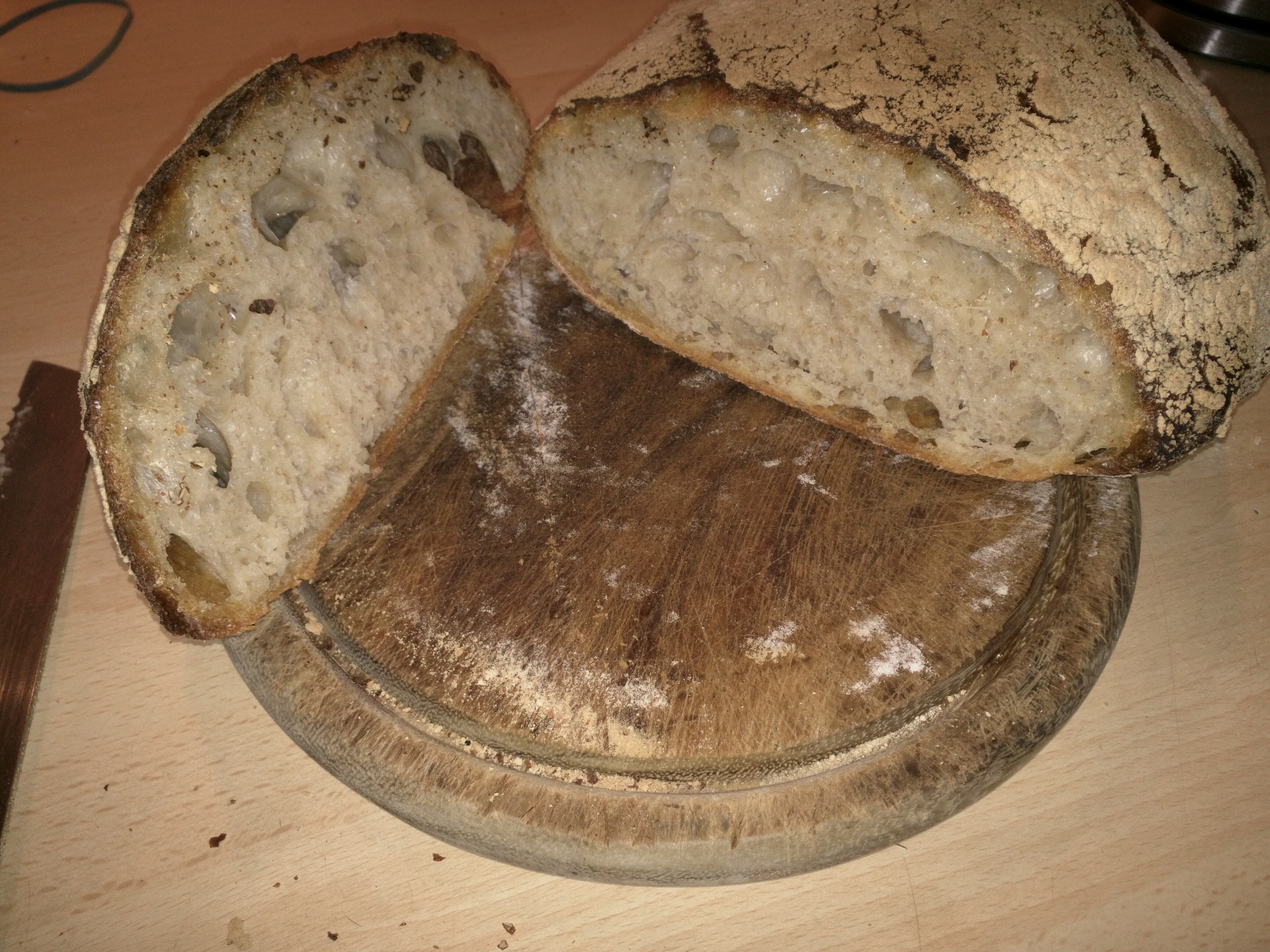
Taste - good. Smelled more sour that it tasted. Big open crumb structure with those much coveted glossy gaps - by some and a chewy crust.
77% hydration - What I discovered was that Robertson doesn't seem to count the starter in the total make-up of the dough. So with his 75% plus my 100% hydration starter, it actually made what I'd refer to 77%.
I more or less stuck to the country Loaf plan in the Tartine book - however I took 200g of starter directly from my jar in the fridge rather then do a separate build to make the starter. As you can see it worked just fine. I also had a slight domestic issue towards the end, so the pattys got an extra hour bench rest while I fixed the central heating...
However - essentially this is possible with UK flours.... But it was a bit of a challenge and not one that I'd ever throw at a first-time bread maker!
I took some more photos and videos, so here are more with descriptions...
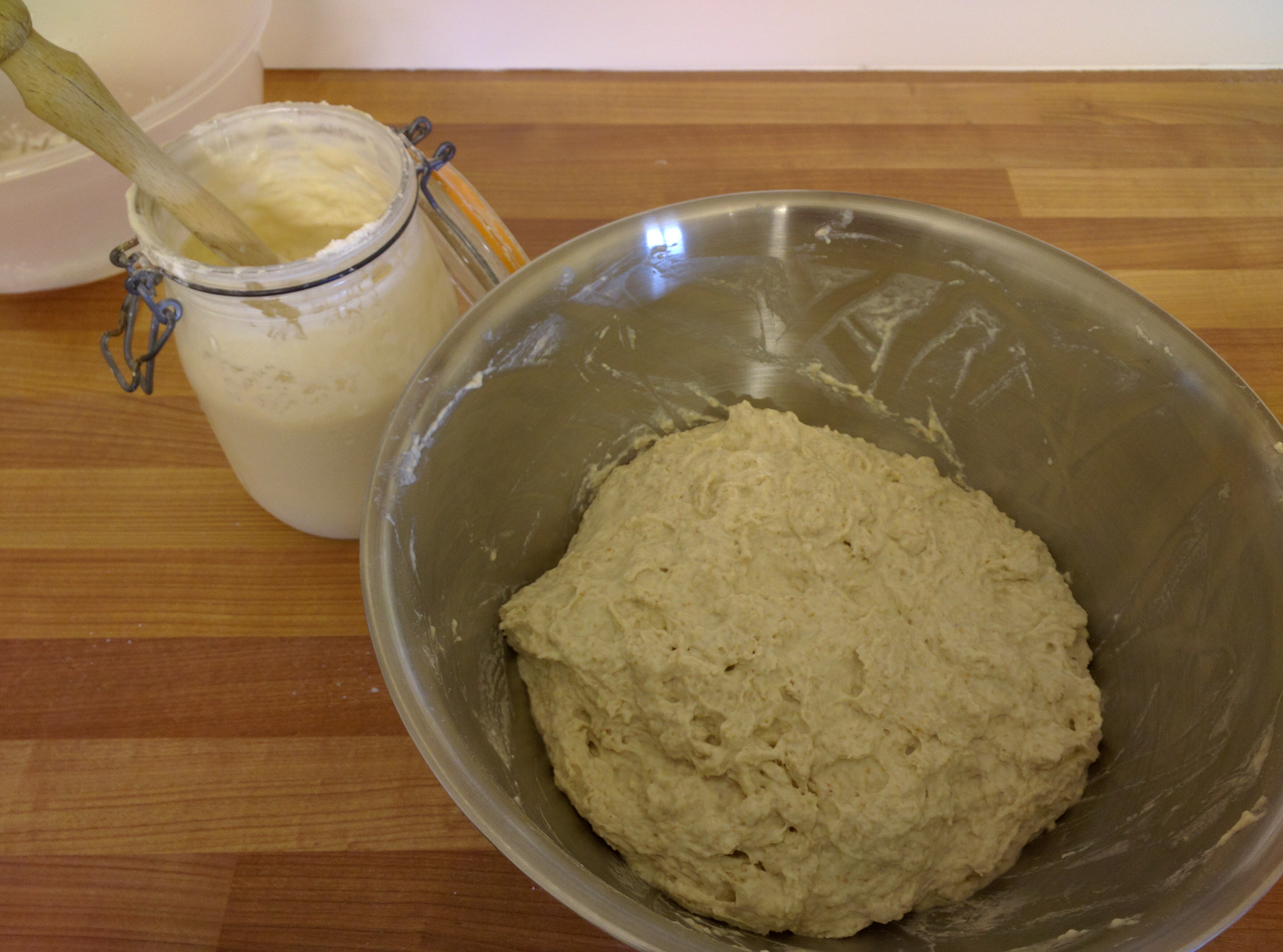
Start of the journey. I've mixed the starter, water (70% of the water) and flours together. The result is almost pourable at this point. Then its left to autolyze for half an hour. The remainder of the water is mixed with the salt and poured over and mixed in... video below:
This is when adding the salt water - I dissolved the salt in the water then added it in. A little video for you which will demonstrate the consistency at this stage. I had to put the camera (phone) down after 30 seconds to finish it off...
What I then did was the pour it out onto the bench with the idea that I'd leave it on the bench, covered with the bowl while I did the turns/stretch & folds on it, however after pouring it out, I realised I had other stuff to do, so scooped it up into one of the bigger polythene tubs I use for bulk fermentation:
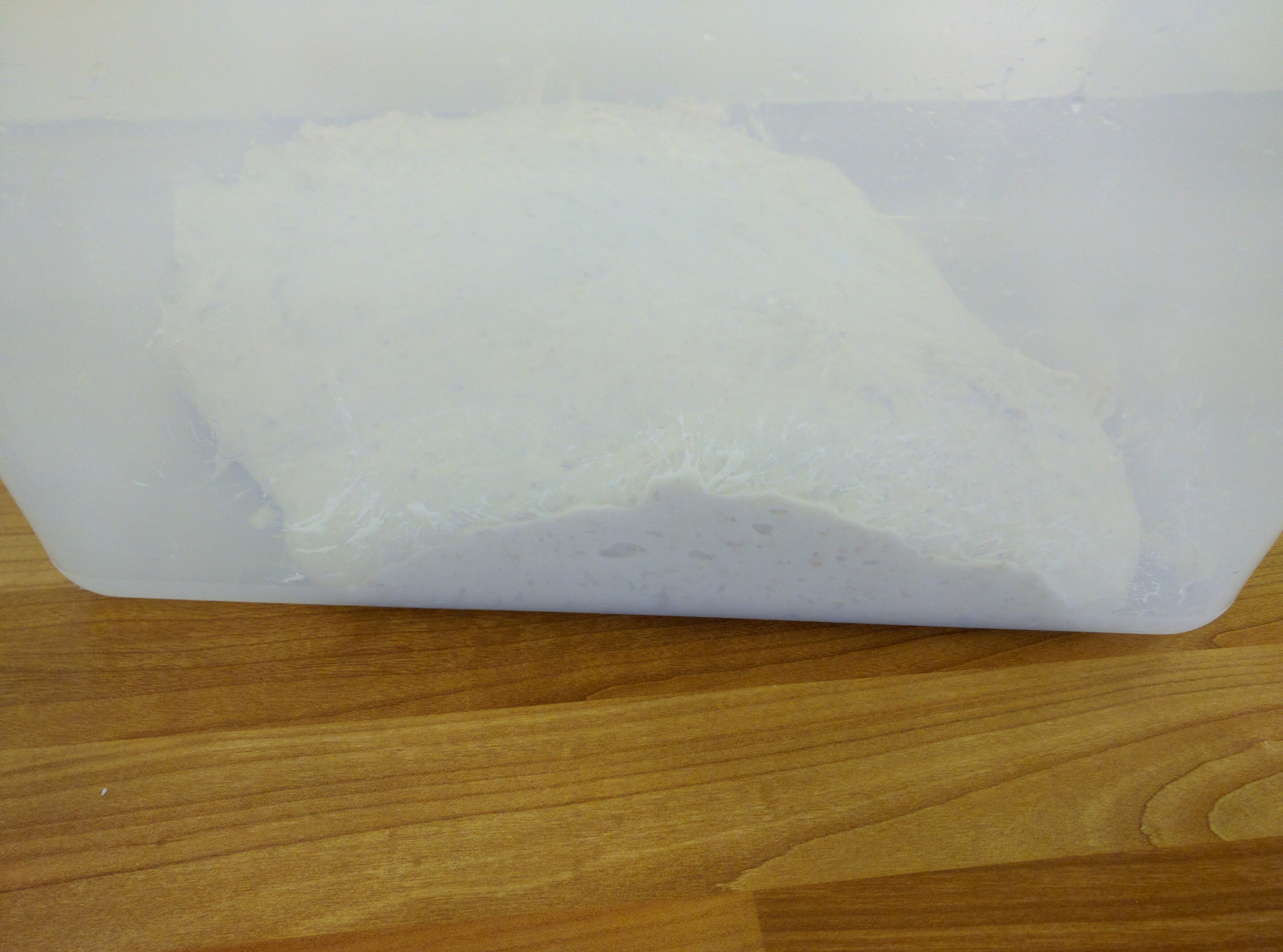
So regular turn/stretch & fold or 3 then repeating this over the course of the next 4-5hours, ending up with:
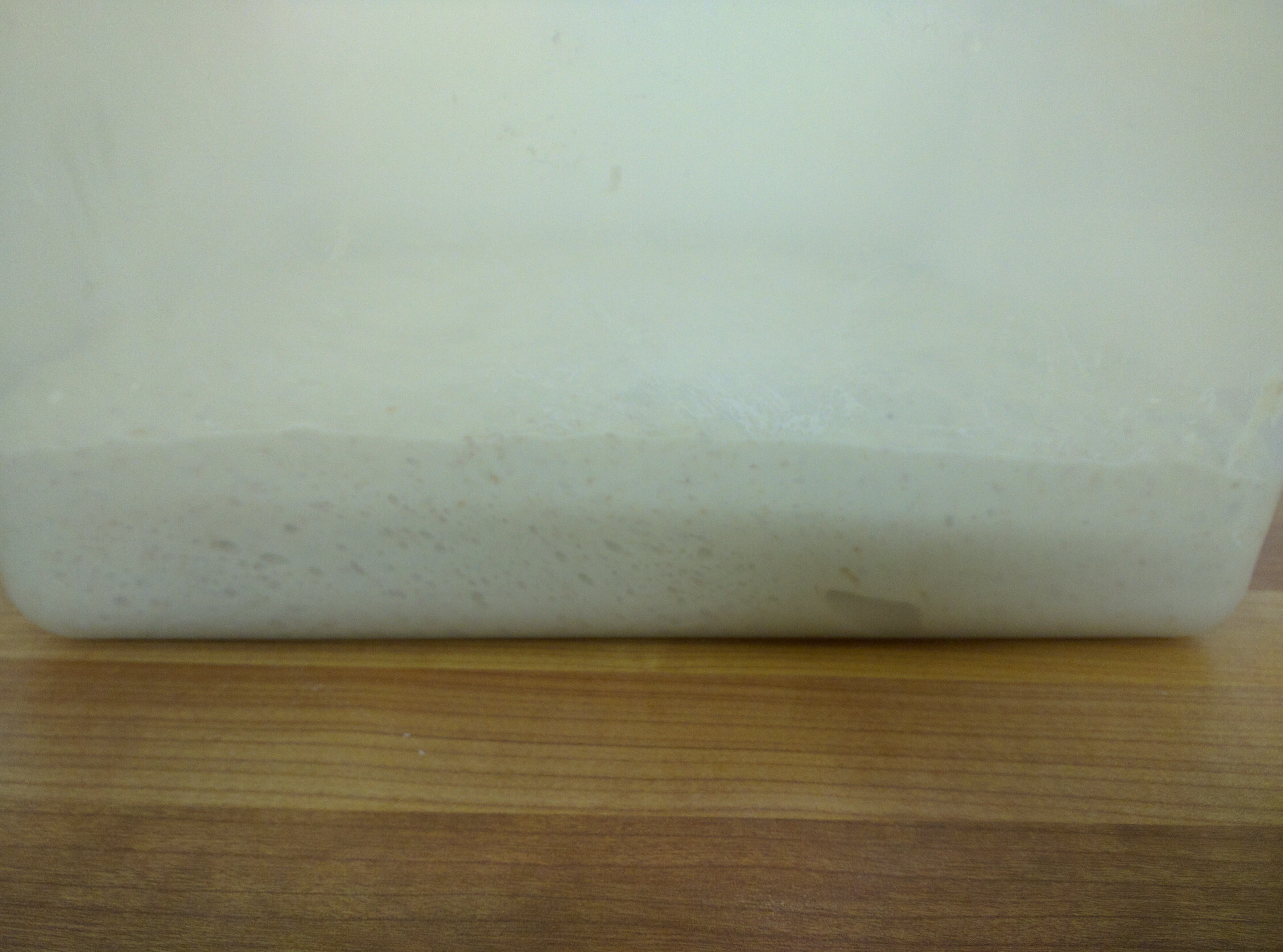
Not the best of pictures due to the rather foggy tub material, but you should be able to see the rise that's happened during the ferment + stretch & folds.
The putty was almost dough-like at this point .. almost. It was wetter than my ciabatta, but it was time to tip it out, divide and rest it ...
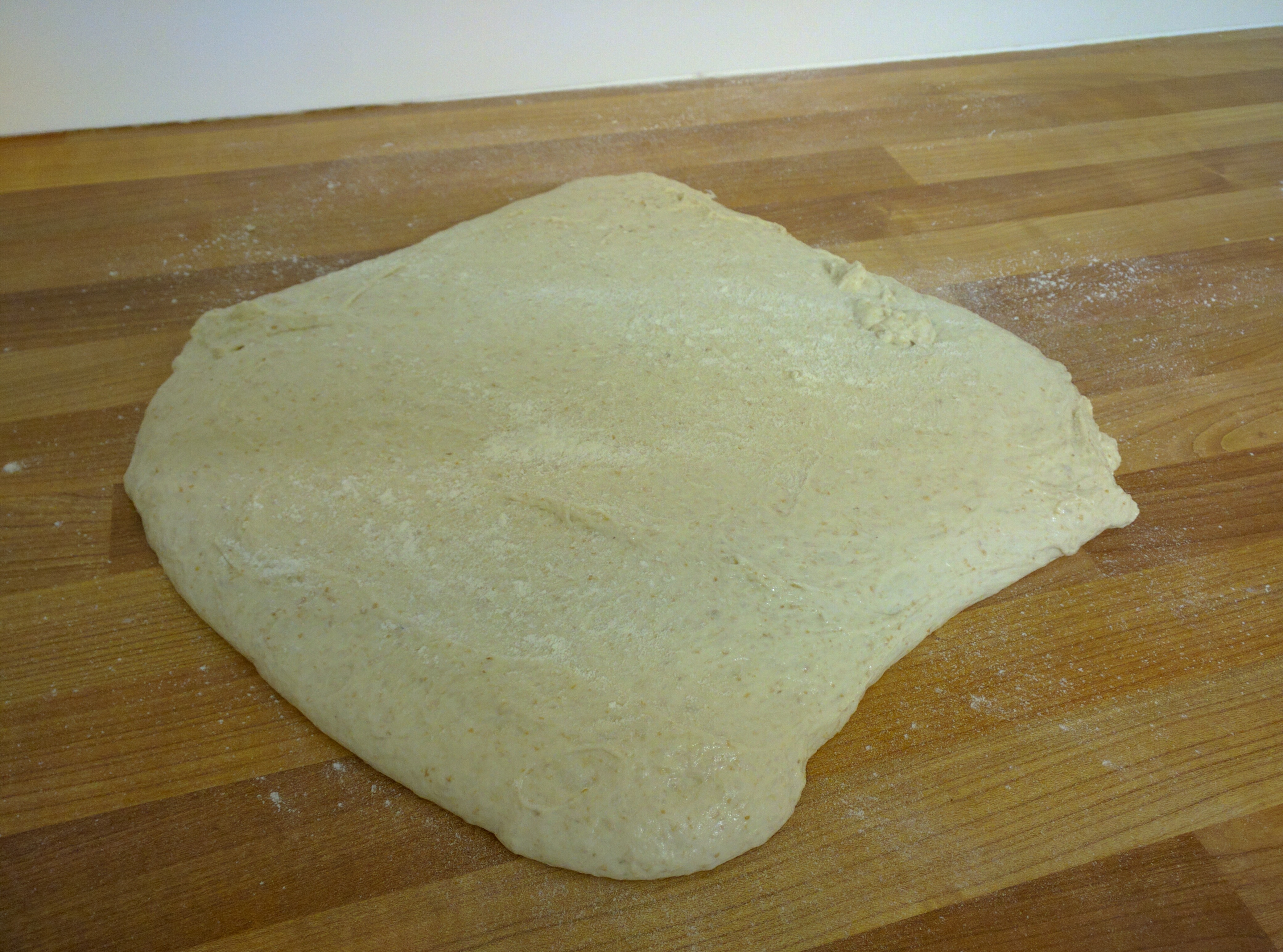
On the bench...
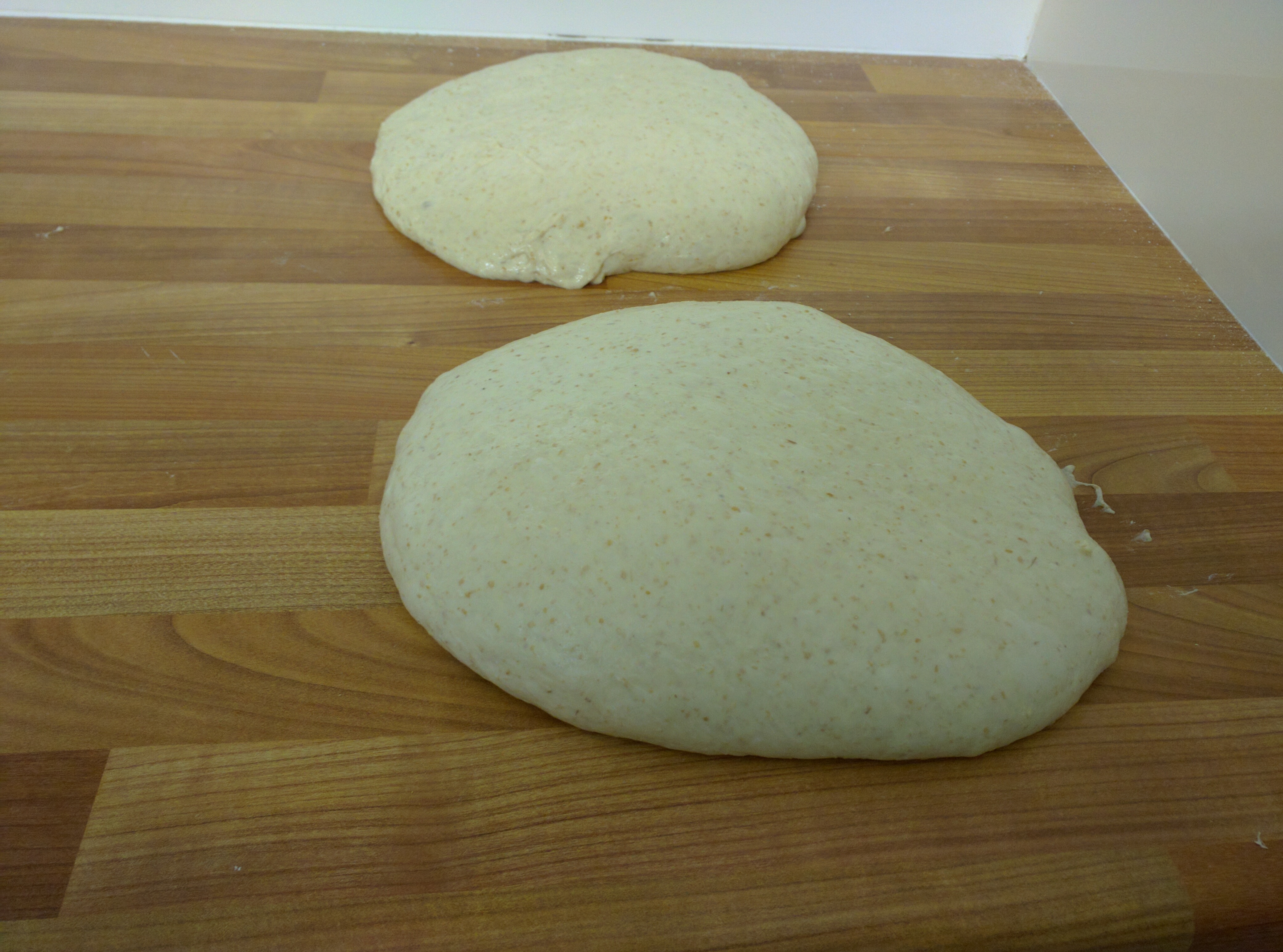
Divided and conquered ... (pre-shape)
Well, almost. At this point, I had to go and fix my central heating which took somewhat longer than I anticipated, so rather than just a 20-30 minute bench rest, it got about 90 minutes... No matter, onward and upward!
I deviated from the book a little at this point and almost managed to do my usual method of shaping a boulle - additional flour helped, but it was still a lot of dough wrangling.. I decided to use cloth lined baskets as this stuff was still a bit too sticky for my liking...
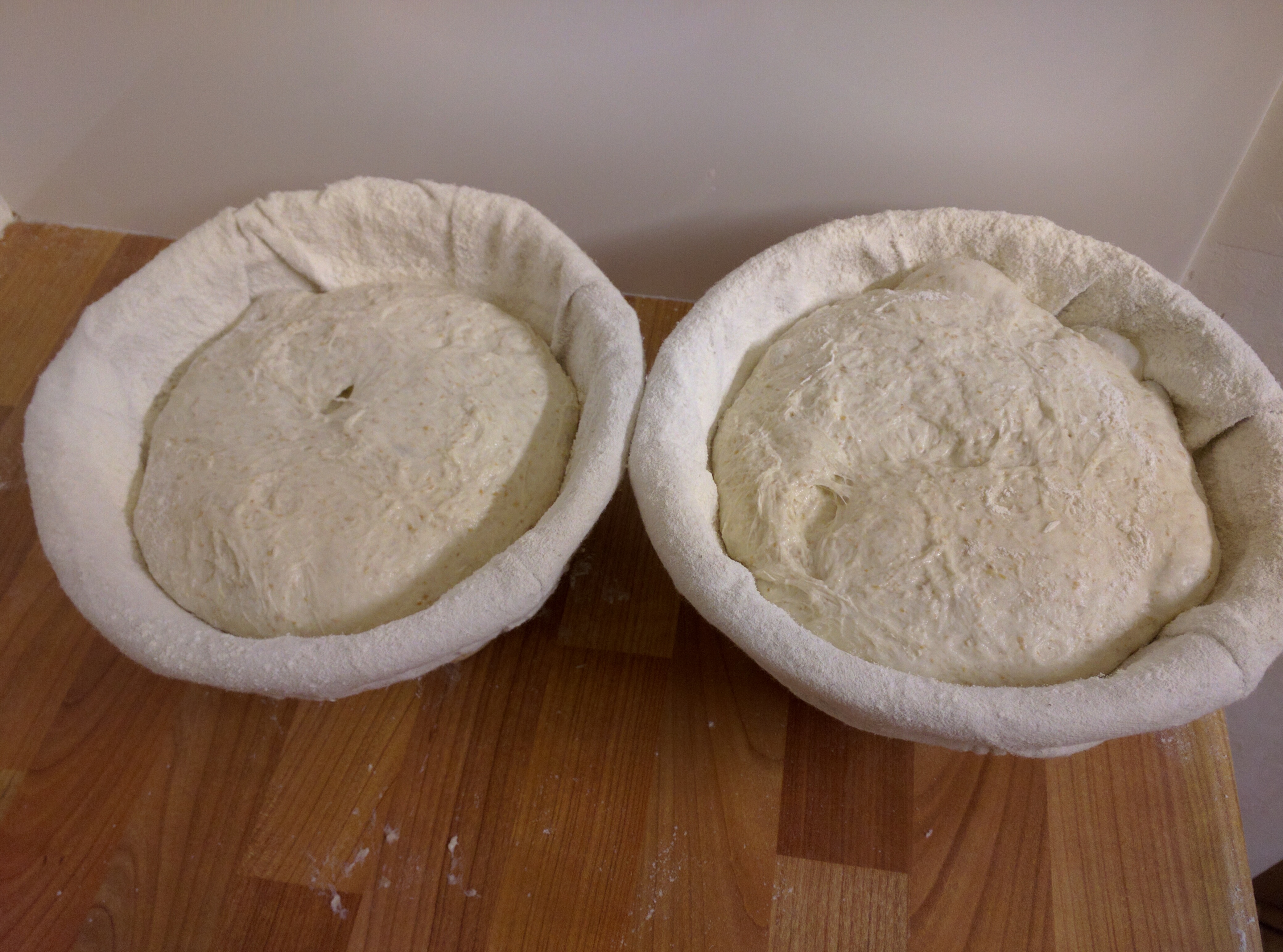
Into the baskets...
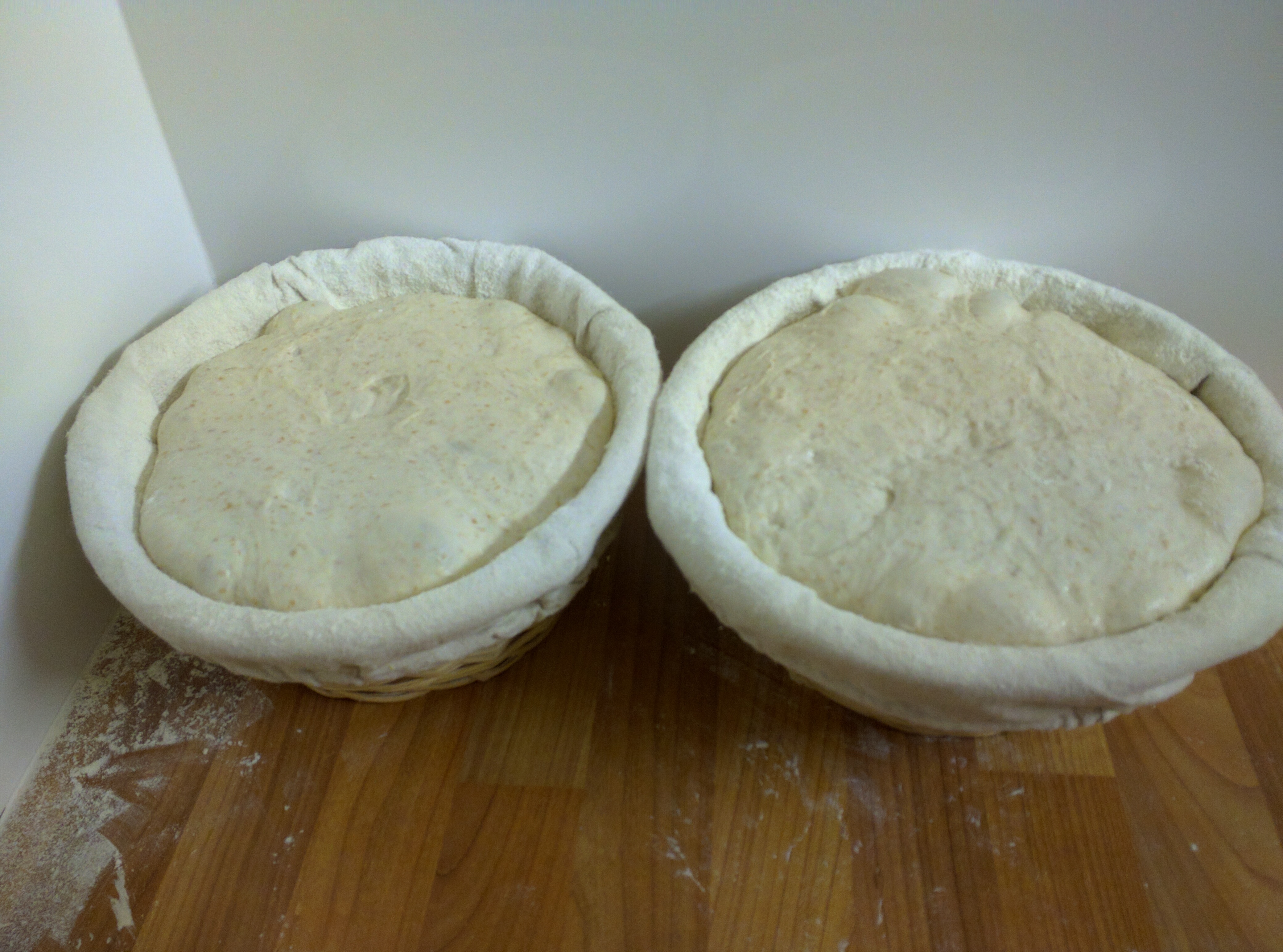
and after a couple of hours proofing (covered with heavy linen) - two baskets of very wobbly & bubbly stuff indeed...
I can see now why people plop this into dutch ovens - stops it smearing all over their ovens if nothing else :-)
During the proof, I'd turned the top half of my Rofco on to heat up - I set it for 240°C - my usual setting for the Rofco is 220°C which is plenty hot enough, but I just wanted to make sure, so ...
The technique I decided to use to load them into the oven was to use a big sheet of re-usable silicone parchment. This is how I usually load it anyway - dough onto the sheet, then use a big plywood transfer board to take the sheet into the oven. I remove the sheet to drop the breads directly onto the stone at the point when I open the vents to let the steam out (needs opening the door, but this hasn't been an issue so-far)
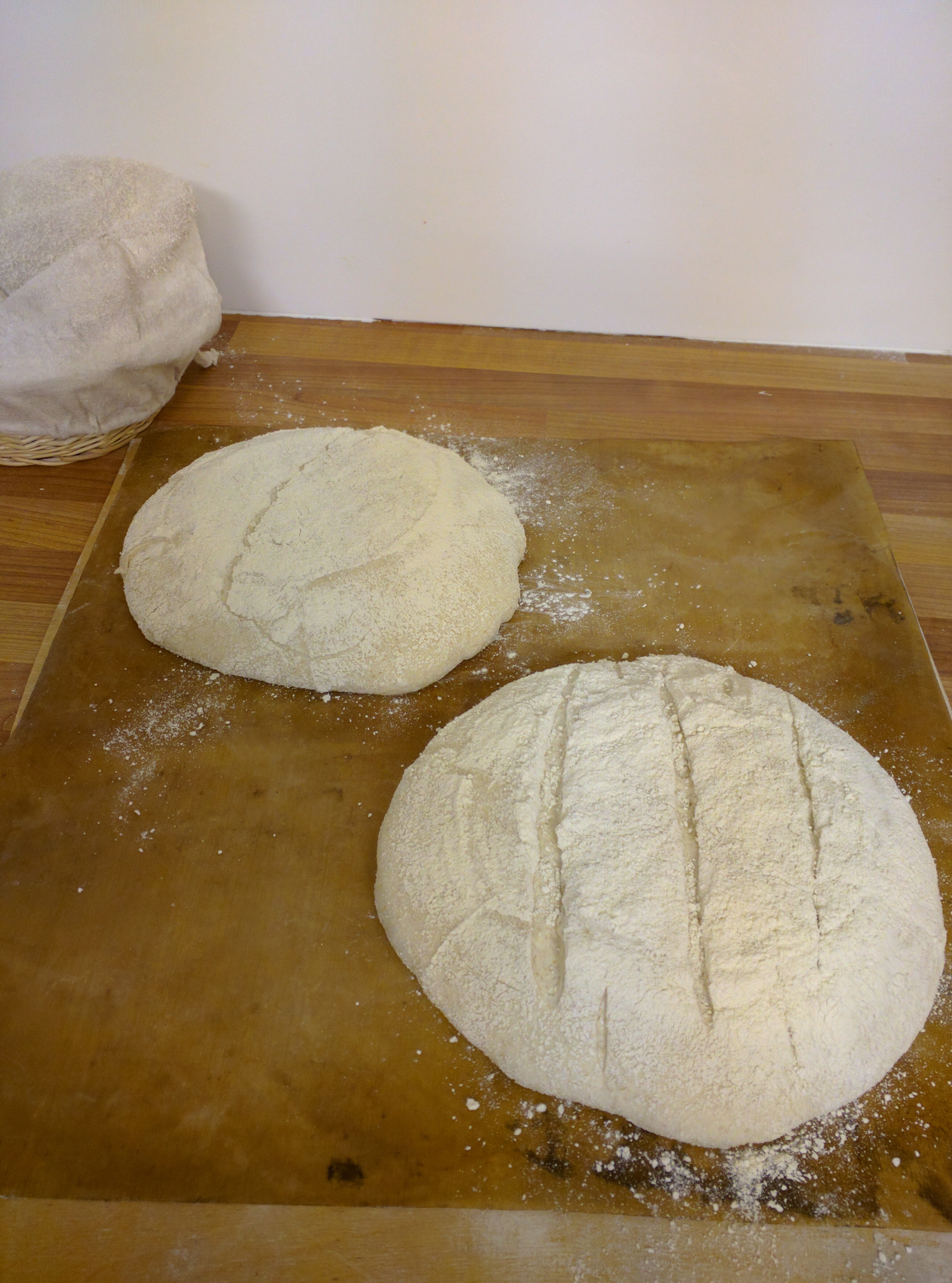
Some light scoring - this was still a very soft dough, then into the oven. I thought I took a shot of them in the oven through the open door, but it doesn't look like it. I steamed the oven before and after loading.
And the result - well, see above. This photo:
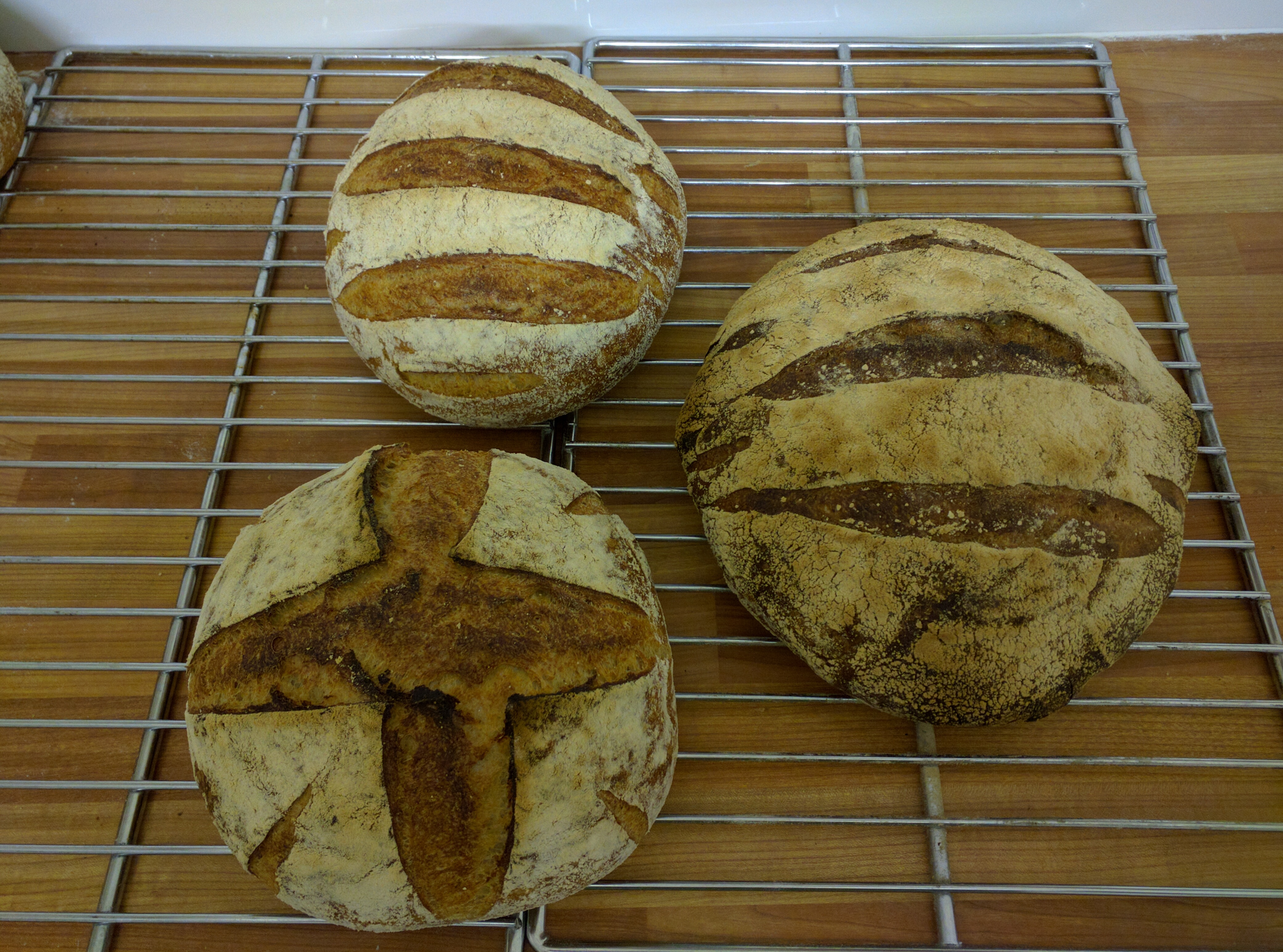
shows the '77' to the right of 2 of my regular 63% sourdough loaves - which bake to about the same weight (840g or so) 77 is larger due to the bigger bubbles - a bit darker too, due to the hotter oven.
Those other loaves have exactly the same ingredients though - same flour, starter, water and salt - just slightly different quantities and a different technique. Quite amazing that the same 3 basic ingredients can produce two completely different loaves!
So obviously handling very wet dough like this takes more practice - but will I make more? I'm really not sure - however that loaf above went to the shop this morning and it sold - the other one that I'd cut into, I gave 2/3 to a neighbour with instructions to give critical feedback (he's good at that :-) so it remains to be seen.
I do know from the markets I attend that people here really do not like (a) sour bread and (b) bread with big holes in it. The UK has not had a history of this type of bread and while I live in hippy/organic central, they only make up a small proportion of the locals in a very rural place, so this new fangled fancy posh bread hasn't quite reached the masses here - yet. But slowly, one loaf at a time and you never know - and there is a local bakery making something very similar (and I know he started with the Tartine book too - wonder if he'd tell me the hydration & flours he uses...)
If I did decide to make it a regular then I'd need to work out a different way to manage it though. baby-sitting it through the day is not going to happen - I have other stuff to do, but the recent post by panifex_velox was interesting - I'll need a bigger fridge though!
Cheers,
-Gordon
I wonder what kind of flour Richard Bertinet uses? I know he bakes in Bath (check out his web page www.thebertinetkitchen.com). Unless he imports it. Probably. :)
I've been experimenting with high-hydration breads too. Sometimes I end up with the consistency of half-set Jello, which makes it challenging for sure! The silicone parchment is a good idea. I'm impressed that you managed to score them!
M. Bertinet certainly used Shipton Mill #4 when I went on one of his courses - but that was at the end of 2007!
He uses Shipton Mill flour (I don't know the exact one). At least he lists Shipton Mill as a supplier in his books. Bath isn't far from Shipton Mill - under 30 miles or so.
Shipton Mill sell French T45 and T65 flours though (not organic, but..)
see e.g. http://www.shipton-mill.com/flour-direct/french-white-flour-type-55-102.htm
I did get some of their T45 once when making some pastry, but I didn't find it any different from the cheap stuff I get from the local co-op. (Organic wasn't a requirement for that particular job)
His basic white dough recipes work out at about 70% hydration too.
-Gordon
same at 72-75% hydration and be much easier to handle and take to production. Having a walk in cooler makes this bread a breeze too. Plus an 18-2 hour retard really makes the flavor pop. If you start with a few and sell it for a euro more than your regular, making it the premium bread it is, then it will likely catch on enough to cover the extra costs involved and you customers will get an education at the same time. I also think it tastes the best at 15-20% whole mult- grains of rye, spelt, oat, barley, etc which doesn't affect the crumb much but the flavor is enhanced dramatically. I think your customers will love these breads.... just like they do everywhere else - and pay more for them too - the most important thing :-) Time will tell!
Well done and happy baking
Adding a euro (€) would be hard as the local currency is pounds (£) :-)
However, even then, local economics wouldn't have it. I live in a town of about 2100 houses ~3000 adults. It's a relatively poor town. We have a local co-op shop who sells the CBP breads (Kingsmill, Warburtons, etc.) as well as their own bake-off (bake from part-baked frozen dough). You can get a basic (800g) loaf for under £1. My 800g "Buckfastleigh Sourdough" sells for £2.50. (small/400g for £1.50)
So adding £1 to the price really isn't going to work as I'm already targeting a tiny fraction of the community (and I'm also selling locally via a shop who want their cut too!)
If I were in any city (or maybe just not in the south west of England) then things would be different. The same bread as mine sells for £4.50 in and around London for example. Flour & electricity costs the same, but people cost more...
One saving grace is that 3 miles down the road is the organic capital of the world - Riverford Farm. (Well, maybe just the UK, but they've been selling organic vegies, meat, etc. for over 30 years now and are pretty big). Also, 3 miles beyond them is Totnes - TQ9 or Narnia as I may have mentioned before. Totnes is a slightly alternative town full of old & rich hippies and wannabe's. However it's an expensive town to live in, so ... A lot of would-be Totnesians live here. And they visit the local wholefoods shop and buy my bread. They're the ones who know what a natural levian is and would be willing to try the more alternative types of bread... The other 99% of the town... Go to the co-op. Totnes is well covered by other organic bread shops, etc. and even though its only 6/7 miles away the logistics and roads (& lack of parking) make it tricky for me to make regular deliveries there)
I also sell via a few other local community shops - they just want weekly deliveries of nice bread to supplement the usual stuff and do some markets. A weekly one I attend is mid-week, so its older, retired and relatively affluent people, but they're old and somewhat traditional in their ways. Fluffy white bread (or wholemeal!) but not bread with big gaping holes in it that won't hold your marmalade... The Saturday morning ones are a much more varied attendance but they're still in very rural communities...
However things have moved on in leaps and bounds in the past 2.5 years since i've been doing bread daily so who knows! I am considering doing more yeasted breads to please a bigger portion of the population - and while I normally only do baguettes for specials, both mornings I've baked this week, I've made baguettes and they've flown out the door - overnight poolish made with a teaspoon of sourdough starter, then normal yeasted dough in the morning. Might be something in that you know... :)
Cranberry & mincemeat sticky buns tomorrow too... not that I'm using up leftovers, oh no ...
-Gordon
We seem to judge the flour only by the gluten percentage. Canadian grain generally has the highest and deemed to be the best. However, this is just one property of a grain when there are so many other attributes to take into consideration when incorporating them into our baking from nutrition to flavour. We have heritage grains grown here which make lovely breads. They may not be the highest gluten content but still make lovely breads when each one is treated according to its own needs. I'm not talking about the plain white fortified bread flour one finds in the local supermarket but the more specialised grains. The rarer wheats which are not hybridised, genetically modified or fortified. There's a lot more out there than we think. Why these should be inferior to Canadian wheats just because their gluten is weaker i'm not sure. I want to try Maris Wigeons next. I might not get the fluffiest loaf but I've heard it's got lovely flavour. If our flours cannot take as much water then so be it... I won't give them as much water.
I've used it myself in the past. It's tricky to get a good loaf out of it due to it's relatively low protein/gluten levels. I used to buy it in 25Kg sacks from Otterton Mill (It's grown over the border in Dorset at Tamarisk Farm) but Otterton used to mix it with a locally grown Canadian variety to make their bread flour).
You can buy it directly off the farm though: See here but note they won't post it to you. (another excuse to come to the West Country, Abe ;-)
You can get some from Shipton Mill too, but they blend it with some continental wheat. See here.
It is a nice flour for pastry though - I made most of my mince pie pastry with it. It can be rolled out very thin too.
But your point about flours is valid, however I wanted a challenge to see if I could make a tartine style loaf with my usual flour - I think I succeeded, but it was harder than I expected - however with a bit of practice then I'm sure it'll become easier, but see my earlier comments about not being a bread I think I can sell here...
Cheers,
-Gordon
I've been eyeing the Shipton Mill one but as you say it has a mix in it. Suppose it depends on the ratios. Now gluten has a bad rap perhaps these wheat variants should be seen as superior. Thanks for the tip about it making a very good pastry. Another thing to think about. I don't mind it not making the fluffiest of loaves, I find it a challenge. We are very used to big fluffy loaves we've lost appreciation for the other qualities of bread which used to be the staff of life. It was meant to be a meal in itself.
I remain rather unconvinced that there is any sort of gluten issues - other than coeliac, of-course. Both Rye and Spelt have gluten, and in some cases (Shipton Mill) their spelt has more gluten in it than their wheat flour... You don't want much gluten in pastry other wise it turns out a bit tough (think chewy bread crust!) rather than "short" and somewhat brittle.
Even when not big fluffy things, you should get some sort of texture with low gluten flours - it just won't hold as many bubbles (of any size) as well as a higher gluten flour - unless you start to add enhancers or beef-up the mechanical action (think Chorleywood which mixes the dough under pressure for a few minutes at stupidly high speeds!) However I do wonder if possibly something like a cooked starch starter (think thang zong) method or a process similar to making 100% rye breads might be way to use very low gluten flours...
Not sure bread was ever meant to be a meal in itself, but as a carrier for other food (Indian, Asian and Italian flat breads for example - even a thin slice of pumpernickel carrying dried meats or cheese) or soup bowls/plate (think trencher in the UK) then it can form a major part of it..
Right. Weathers looking OK, off to the beach to celebrate the new year soon!
-Gordon
But hey, its fashionable nowadays and if it means experiencing "new" flours it can only be good. I love finding out about these less common wheat varieties and trying them out. Why just stick to the same common flour? I'm going to really start incorporating a wider variety of flours. My last bake with a rye flake soaker and molasses was so good. Baked it on Saturday night and its still fresh, just had some.
Happy New Year Gordon. Hopefully in 2016 I'll get to taste some of your bread.
P.s. it's not that spelt has less gluten rather, a different type of gluten
Really - view this as humour - it's American, but feels quite British...
https://www.youtube.com/watch?v=Oht9AEq1798
Enjoy,
-Gordon
Very dry (like gluten free bread) sense of humour :)
Haha, that's so funny. :) Thanks, Gordon!
LL
That is excellent.
Abe
I knew you had a new bread coming, but I must have missed the post.
So, Rye flake meaning the bran?
Any pics?
dobie
Substituted jumbo rolled oats for rye flakes. They look like rolled rye so thought they'd be good. And they were!
http://www.thefreshloaf.com/node/44438/molasses-whole-wheat-and-rye-levain
Hope you like it Dobie
Gordon
Thank you for the ''Up Close and Personal' details. It is not only helpful in understanding your circumstances (and thus posts) more clearly, but it is also good food for thought regarding my own fantasies of a somewhat similar persuit (however far off that might be).
dobie
ps - there is some Script or another on this thread that puts my computer into a 'Cold Retard', so I will catch up with you on the next one.
dobie, I was having all kinds of script issues on the site, until I installed AdBlock Plus (it's free). If I hover over the AdBlock icon I can see there are all kinds of weird scripts running on this page that are now blocked. My computer was running very hot (fan on high) when I first came on the site, and now I have no problem at all. Works well on Facebook too! :)
I am cooking in Yorkshire. I don't seem to have this problem with flours. I mostly use Bachelde water ill organic strong flour which I can get from Amazon on a subscribe and save basis. I tried shipton mill at the beginning, at least partly because Richard Bertiner recommends it, but I didn't love it. I use leckford farm or the straight waitrose strong flour when I run out of Bachelde and haven't had any major issues along the lines of these. I follow the tartine recipes exactly and although my first ones looked liquid and were v hard to shape, I don't have that problem any more so have assumed it was down to my earlier lack of understanding of the dough and rubbish shaping. I do struggle to get the level of oven spring that I see some others get on here but had again assumed it was my poor technique.
worth trying the Bachelde and seeing what happens?
Hi,
So the object of my exercise was to see if I could follow the tartine method with my usual flour - which I've had real issues with in the past with high hydration mixes - what I probably didn't say clearly was that the experiment was more or less a success and I'm sure it's down to the actual mechanisms of mixing/folding and the schedule. Sadly this will not fit into my schedule... And its also not a bread that my customers will buy. I'm sure with more practice I could get a lot better using Shipton Mill flour, but it's not going to happen for a number of reasons.
I'm assuming you mean flour from Bacheldre Watermill... That's not going to happen either as it's far too expensive - and they only sell it in 1.5Kg bags - I'm using 70Kg of flour a week right now, so that bag size really isn't practical. I do note that their strong white comes out at 14.9% though! I've also tried stoneground white flour in the past - and been a bit disappointed by the colour - dull grey when baked, however maybe that's just how Cann Mill does it and Bacheldre has better sifters...
However I'm in the process of switching to Marriages flours anyway - their organic white is also 14% protein, so we'll see what happens there.
Cheers,
-Gordon
Sorry I clearly misunderstood! Yes I can see how that would not work for you. It's a lovely white soft flour but clearly wrong for what you need. I have used marriages in a pinch but prefer Batcheldre (sorry for autocorrect spelling variations above).
Good luck with your quest!
Every now and then I did try something new, so I'll put it on the list.
Gilchesters flour is nice to use, but again expensive via mail-order. Bakery bits is in Devon, but still the best part of an hours drive and they've recently started a heritage flour section, so plenty to choose from.
The current flour(s) under test are White Wheat - (Marriages Golden Wheat) both strong for bread and softer for pastry. It's a strange stuff - white (or at least very pale cream) bran - but wholemeal! Not organic though, but I'm going to try it out on some of the regulars who would by my usual 100% wholemeal loafs at one of the markets I do next week.
-Gordon